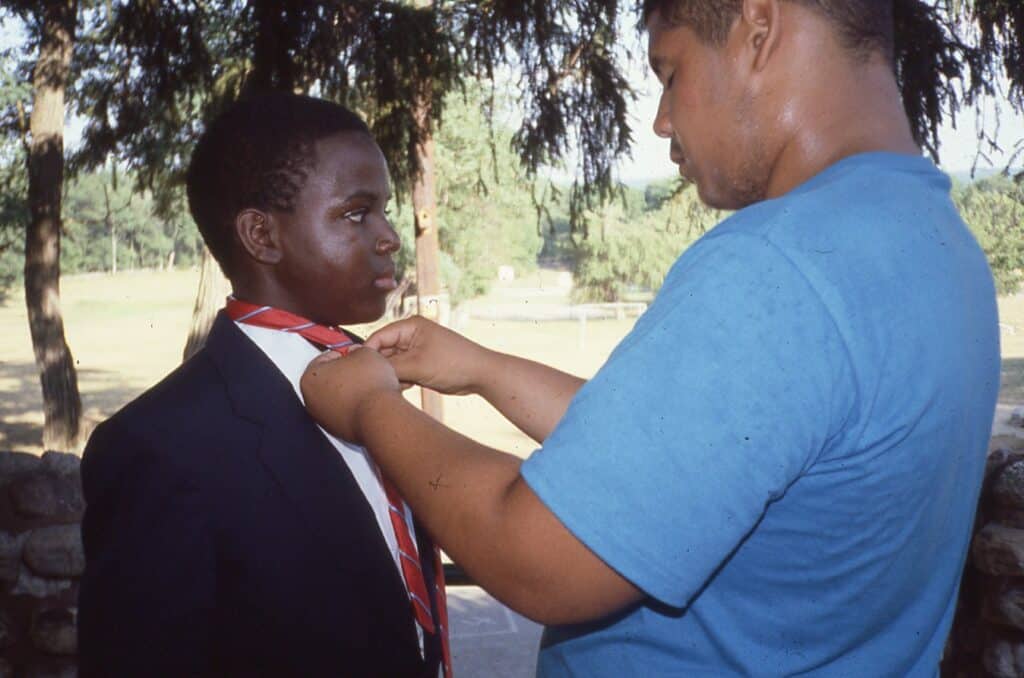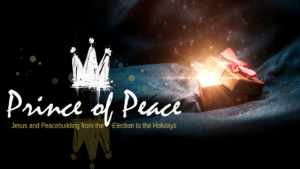It Had Become our Nest
I am a nature-lover. Better yet, a wildlife enthusiast. One summer, outside of my window in the room I stayed in at Camp Deerpark, I watched a bird begin to build her nest, twig by twig. Then a few days later, I watched her lay her eggs in that very same nest. Later I witnessed those eggs hatch into small hungry miracles. Eventually, each one of her birds learned to fly. I watched the nest become empty again. This is the story of how Camp Deerpark impacted my life, the youth I worked with, and the lives of my children. I am like that bird.
I was born on a New Jersey chicken farm in 1940. I was raised in Coatesville, Pennsylvania, and at age 11 started attending Newlinville Mennonite Church, one of the first Mennonite Churches established in a Black community. Our pastor invited us to attend Camp Men-O-Lan, also in Pennsylvania, where I met other children of color from DC, Philly, Harrisburg and Reading. My counselor at Men-O-Lan was John Kraybill. I remember building a great relationship with him, and my age mates. As a teenager, I desperately wanted to attend Lancaster Mennonite High School, to keep in touch with many of my Camp Men-O-Lan friends, but my mother made it very clear that I was going to the local school where the rest of my family had attended. “If it was good enough for them,” she told me, “then it’s good enough for you.” She was right. I graduated the top boy of my senior class.
In 1961, at 21 years of age, I was ready to leave Coatesville. I tagged along with a friend of mine who was heading to New York City to be a 1-W, which was the legal status given to conscientious objectors of war. In exchange for enlisting in the military, we were required to complete a certain number of hours of community service work.
So that’s how I found myself in Harlem. And, boy, was I scared. Of course I had seen Black people in Black communities; but not at this level. Harlem was tougher and rougher than Coatesville. My small apartment was right next door to the Seventh Avenue Mennonite Church. Thankfully, at the time, the pastor, and the person in charge of placing the new 1-Ws, was none other than John Kraybill, my counselor and good friend from Camp Men-O-Lan!
Soon after, I became a member of the church, and served as their Youth Leader. In 1966, when Kraybill left New York City, I became the lead pastor. The church began a youth center and I was the coach of a community basketball team. I was known as the “Hoodlum Priest,” because many of our youth had intimidating reputations.
One of our players, Jack, a flashy 17-year-old, often visited the center. I knew he was dealing drugs, and tried to warn him about his lifestyle. “I can make more money in a week than you make in a year,” he told me one day. He was probably right. I had quit my job to become a teacher in one of the most notorious junior high schools in Harlem. Still, I was worried that I couldn’t give Jack what he needed most to survive the streets.
And then late one night, there was a knock on my door. The basketball team spilled the horrible news, “Jack is dead; they killed him.” His flashy lifestyle was a threat to the wrong people. As devastating as the news was, it fueled my passion to work with youth even more. I vowed there would be no more “Jacks.” Not if I could help it.
In 1968, soon after the assassination of Reverend Dr. Martin Luther King Jr., the Mennonite Minority Council was established. The purpose of the council was to diminish the large disparity between money given abroad, and money given to the local community. Around the same time, there were also talks within the Mennonite churches of purchasing a campsite near New York City. As I visited various locations with other Mennonite pastors, I kept Jack in mind. I was looking for a place where the youth of my community could know God, peace, brotherhood, and love. It had to be a safe place, a place to rescue our youth from the dangers of Harlem’s streets. “No more Jacks,” I told myself.
We finally settled on Camp Deerpark. With funds from the Mennonite Minority Council and young adults from the Mennonite Voluntary Service Center, we had plenty of helping hands at our Youth Center in Harlem and at Camp Deerpark during the summer. Every spring we would help fill out paperwork and set up doctors’ appointments for about 30 of our youth to be able to spend time at Camp Deerpark.
It was a dream come true to see my youth run through the grass, and walk through the woods, and enjoy nature as much as I did. Even my own biological children, all six of them, grew up in the safety of Camp Deerpark. It had become our nest, nature’s sanctuary to us.
The nest is empty now. My children, Anita, Richard, Melody, Robert, Shawn, and Kiesha, are all independent adults now. Surely, Camp Deerpark was vital in all of them establishing their faith, growing and maturing spiritually, and finding God’s will for their lives. The Harlem youth and basketball teams are all grown up and leading their own lives now too. All I ever wanted was for them to see the world as God sees it. They have all learned to fly. They are all miracles. Camp Deerpark helped me do that.
—Written by Celmali Jaime Okonji, program director in 2006–7, attended Evangelical Garifuna Church and King of Glory Tabernacle, both in the Bronx.
Richard “Dick” Pannell is a retired podiatrist and lives in New York. He is the former pastor of Seventh Avenue Mennonite Church in Harlem.
Related Entries
Share:
“How Do I Donate?”
Recently, a thirteen-year-old guest at Camp asked Operations Director Kevin Smith, “how do I donate?” Kevin was honestly a little surprised, but was happy to see this young member – who was on retreat with one of our owning churches — taking some initiative. Kevin directed him to the website Donate page, and the young…
The Discipleship Down-Low
Defining Discipleship 18 And Jesus came and said to them, “All authority in heaven and on earth has been given to me. 19 Go therefore and make disciples of all nations, baptizing them in the name of the Father and of the Son and of the Holy Spirit, 20 teaching them to observe all that I have commanded…
The Virtuous Wife
This past weekend, Camp hosted three women’s retreats at Camp. Though the retreat groups were very diverse in background – one was from an urban church plant in Philadelphia, one was from a Garifuna Mennonite church in Brooklyn (an Afro-Caribbean Culture), and one was from a multi-ethnic faith community reaching out in North Jersey. Though…
A Life of Service
I believe the most important thing to God is not our personality, knowledge, or talents, but our availability. How willing and ready are we to respond when He calls, and how ready are we to do what He says? What use to the Lord are people who could do what he wants with excellence and…
Building Belonging
At our February NYC LMC District meeting, we’re discussing the Belonging phase of The Journey Map. In this first phase on the map, individuals and groups on a spiritual journey begin the process of connecting to each other and evaluating the place they may have in each other’s lives. Have you ever been an outsider…
What Are You Tapped Into?
Yesterday we began tapping maple trees, officially opening maple syrup making season at Camp Deerpark! Last year, the transition kept us from producing syrup, so it feels great to be back to it. Starting off, however, has been a bit of a challenge since things are pretty arctic around here. The entire ground is covered…
What Does it Mean to be Spirit-Led with Pastor Mark Perri
One small contribution I can make is to share story with you. This could be valuable in several ways: First, I’m coming to the Mennonites from the outside — from non-denominational GenX “simple/ organic/ emergent church“. Sometimes people coming from outside-in have a helpful perspective for those trying to move from inside-out. Second, as an…
2025 NYC LMC District Call Schedule
Mark these dates in your calendar if you’re part of the NYC LMC District and want to attend the English-language fellowship and resourcing calls led by Bishop Hyacinth Stevens: January 27th – 6:30 PM February 24th – 6:30 PM March 31st – 6:30 PM April 28th – 6:30 PM May 19th – 6:30 PM June 30th…
Winter: Life Under the Surface
On the surface, winter with its cracking and cold seems like the enemy of life. Everything sleeps as though dead, and Camp — quiet and empty — sits waiting. But under the surface, winter is revealed to be a friend to life, not an enemy. In the deep frost, God opens the soil for Spring’s…
Peace Making Presents
This is Session 4 of the Prince of Peace: Jesus and Peacebuilding from the Election to the Holidays webinar series. Advent celebrates the central fact that God began building peace with us by giving a Gift. Following this example, gifts are a powerful tool for peacebuilding in our lives, relationships, and organizations. We’ll explore how…



